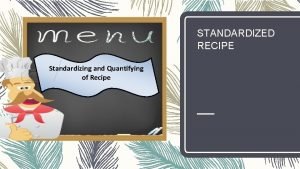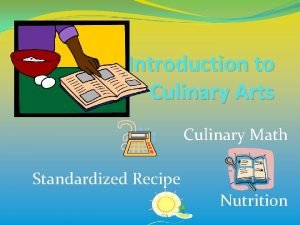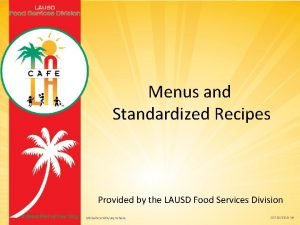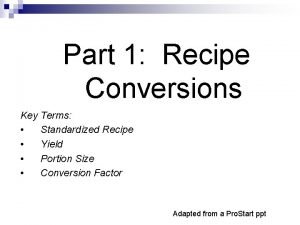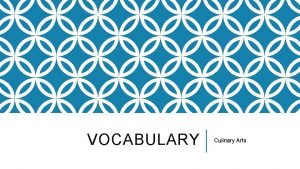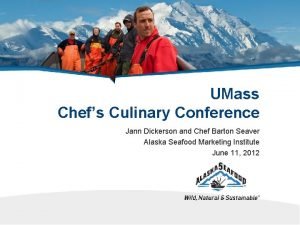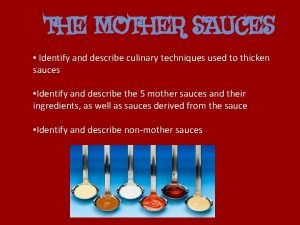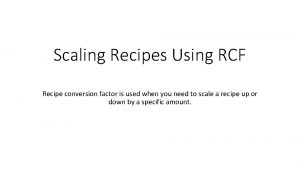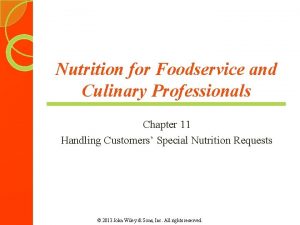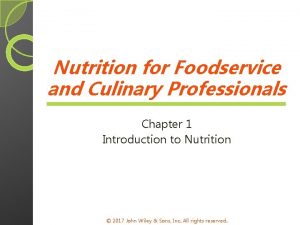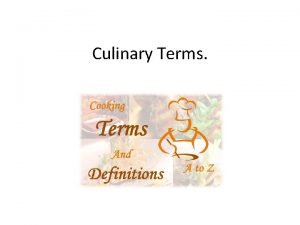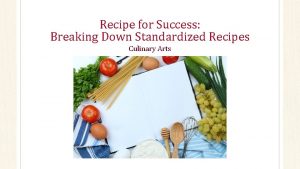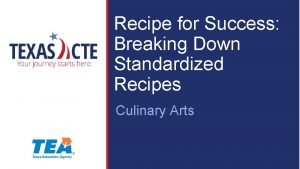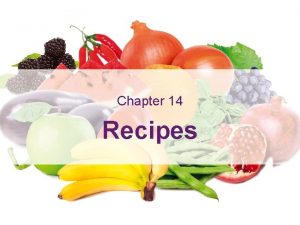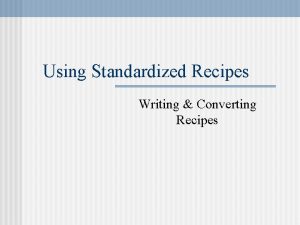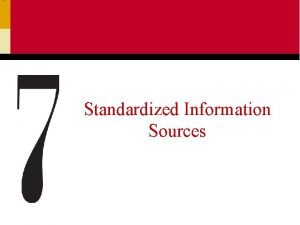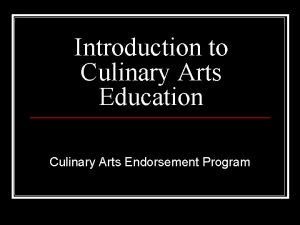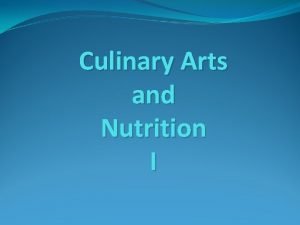READING RECIPES Intro to Culinary Standardized Recipes Standard













- Slides: 13

READING RECIPES ü Intro to Culinary – Standardized Recipes ü Standard: CA-ICA 8 Students will examine and identify standardized recipes and their role in the commercial kitchen 1 © 2002 Learning Zone Express

Introduction ü Most cooks use recipes. A recipe is a list of ingredients that gives you directions for preparing a specific food. If you know how to follow recipes, then you will be successful in the kitchen. Who knows! You may become a famous chef! 2 © 2002 Learning Zone Express

History ü Before people could read and write, recipes were passed down by word of mouth ü Measurements were not exact. ü No standard measuring cups/spoons Quick Pudding Beat up 4 eggs, add a pint of milk and a little salt and stir in 4 large spoonfuls of flour and a little nutmeg and sugar to your taste. Beat it well and pour it into buttered tea cups, filling them half full. They will bake in a stove or Dutch oven in 15 minutes. 3 © 2002 Learning Zone Express

Today: Recipe Formats (styles) ü Standard Format: Lists ingredients in order of use Step by step directions This is the most common format ü Narrative Format: ü Recipe is written in paragraph form This is not common – usually done when space is limited such as on the back of boxes or cans 4 © 2002 Learning Zone Express

Why standardized recipes? ü Process of standardization means each item will be the same ü Different cooks will take the same recipe and it will look, taste and be portioned the same each time it is served ü This is important to customer service or customer expectations ü Employees/chefs cannot be creative in the professional kitchen 5 © 2002 Learning Zone Express

Introduction ü Successful cooks know: • How to read a recipe • Abbreviations • Measuring Techniques • Equivalents • How to Change a Recipe 6 © 2002 Learning Zone Express

What’s in a recipe? ü A formula! ü Read the recipe before you cook. The parts of the recipe tell you: • • 7 Name Ingredients and amounts Equipment Directions or Method Time and temperature Yield (number of servings)( Professional Yes) Sometimes - Nutritional Analysis © 2002 Learning Zone Express

Parts of a Recipe Name What the recipe is called. ü A recipe usually includes: Quesadillas Yield (Serves 4 - 2 person) Number of servings the recipe makes. 8 flour tortillas 1 cup grated cheese Ingredients 1. Heat a frying pan over medium heat. Equipment 2. Place a tortilla in the pan. 3. Sprinkle 1/4 cup cheese on the tortilla. 4. Cover the cheese with another tortilla. Directions Or Method Steps you follow to make the recipe. 8 5. Cook about 1 minute, until brown and crisp. Then turn the quesadilla over. Cook until the cheese melts. 6. Place on a serving plate. Cut into pie shaped wedges. 7. Repeat process with remaining ingredients. © 2002 Learning Zone Express Food products you need to make the recipe.

Professional Recipe ü May be large quantity ü May be written by weight or in metrics ü Instructions called Method ü May have specific plating instructions 9 © 2002 Learning Zone Express

Your turn ü Find a recipe ü Mount it on a piece of paper ü Identify each part of the recipe Answer the following questions: What special equipment is needed to prepare this recipe? List three cooking terms in this recipe (example: saute, fold) 10 © 2002 Learning Zone Express

What’s an Abbreviation? ü Understanding the language of recipes takes the guesswork out of cooking. ü Abbreviation - The shortened form of a word. ü Abbreviations in measuring units: • Save space on the cookbook page. • Make recipes easier to read. 11 © 2002 Learning Zone Express

Name the Abbreviations ü The U. S. uses the English system: • Teaspoon • Tablespoon Tbsp. or T. • Cup c. • Pint pt. • Quart qt. • Gallon gal. • Ounce/fluid ounce • Pound 12 tsp. or t. © 2002 Learning Zone Express oz. / fl. oz. lb.

Name the Abbreviations ü Most other countries use the Metric system: 13 • Milliliter ml • Liter L • Grams g • Kilogram kg © 2002 Learning Zone Express
 Standardized ingredients culinary definition
Standardized ingredients culinary definition Chocolate chips
Chocolate chips The quantified recipe must be tested and standardized
The quantified recipe must be tested and standardized Standardized recipes menu
Standardized recipes menu What is a recipe category
What is a recipe category Pre reading while reading and post reading activities
Pre reading while reading and post reading activities Slurry definition culinary
Slurry definition culinary Chef culinary conference
Chef culinary conference 6 mother sauces
6 mother sauces Rcf culinary
Rcf culinary Chapter 11 culinary nutrition
Chapter 11 culinary nutrition Nutrition for foodservice and culinary professionals
Nutrition for foodservice and culinary professionals Los angeles harbor college culinary arts
Los angeles harbor college culinary arts Culinary terms
Culinary terms
